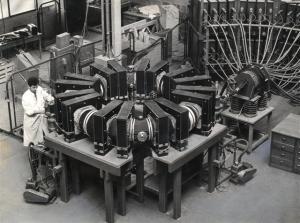Supersize me!
Size matters, especially when dealing with fusion machines. But when the picture below was taken, in the late fifties at Fontenay-aux-Roses, near Paris, where French CEA operated an embryonic "fusion service", no one had yet figured the importance of the "scaling laws" : plasma volume in TA-2000 was a fraction of a cubic meter — ITER's will be close to 1 000 m3 — and chances for fusion reactions were exceedingly low.
Not that the physicists operating this early "toroïdal pinch" machine really expected them, says Jean Jacquinot, the former head of fusion research at CEA, who started working at Fontenay in 1961 . "TA-2000's main accomplishment was to demonstrate how ignorant all of us were about plasma physics. We understood the individual behaviour of particles, but we didn't have the slightest notion about their collective comportment. We didn't know there was a Devil in the plasma..." Instabilities, "dreadful confinement", were the names of that Devil. Spectrograph operators would ask the machine operators if they had not, by accident, mixed "coal" with hydrogen, for the spectrograms showed more carbon atomic lines than anything else — an evidence that the plasma was in violent contact with the Pyrex walls of the machine.


